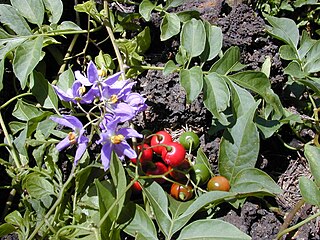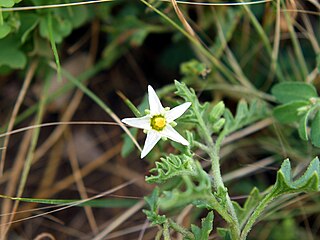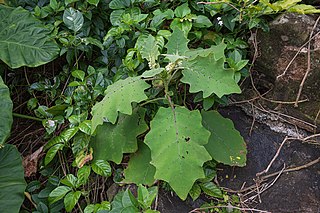
Solanum is a large and diverse genus of flowering plants, which include three food crops of high economic importance: the potato, the tomato and the eggplant. It is the largest genus in the nightshade family Solanaceae, comprising around 1,500 species. It also contains the so-called horse nettles, as well as numerous plants cultivated for their ornamental flowers and fruit.

Solanum dulcamara is a species of vine in the genus Solanum of the family Solanaceae. Common names include bittersweet, bittersweet nightshade, bitter nightshade, blue bindweed, Amara Dulcis, climbing nightshade, felonwort, fellenwort, felonwood, poisonberry, poisonflower, scarlet berry, snakeberry, trailing bittersweet, trailing nightshade, violet bloom, and woody nightshade.

Solanum americanum, commonly known as American black nightshade, small-flowered nightshade or glossy nightshade, is a herbaceous flowering plant of wide though uncertain native range. The certain native range encompasses the tropics and subtropics of the Americas, Melanesia, New Guinea, and Australia.

Solanum mammosum, commonly known as nipplefruit, fox head, cow's udder, or apple of Sodom, is an inedible Pan-American tropical fruit. The plant is grown for ornamental purposes, in part because of the distal end of the fruit's resemblance to a human breast, while the proximal end looks like a cow's udder. It is an annual in the family Solanaceae, and part of the genus Solanum, making the plant a relative of the eggplant, tomato, and potato. This poisonous fruit is native to South America, but has been naturalized in Southern Mexico, Greater Antilles, Central America, and the Caribbean. The plant adapts well to most soils, but thrives in moist, loamy soil.

Solanum nelsonii, common names pōpolo and Nelson's horsenettle, is a partially woody sprawling shrub-like perennial plant in the family Solanaceae, part of the Solanum or nightshade genus. This poisonous plant is endemic to the Pacific Islands. It grows low in coastal sites in coral rubble to pure sand.

Solanum elaeagnifolium, the silverleaf nightshade or silver-leaved nightshade, is a species of plant in the nightshade family native to North and South America. It is common in parts of southwestern USA, and sometimes weed of western North America. Other common names include prairie berry, silverleaf nettle, white horsenettle or silver nightshade. In South Africa it is known as silver-leaf bitter-apple or satansbos. More ambiguous names include "bull-nettle", "horsenettle" and the Spanish "trompillo".

Solanum sarrachoides is a species of South American nightshade known as the hairy nightshade or leafy-fruited nightshade.

Solanum citrullifolium is a species of flowering plant in the Solanaceae family. It is a nightshade referred to by the common name watermelon nightshade, as its leaves somewhat resemble those of a watermelon plant. It is a white-stemmed shrub with purple star-shaped flowers. It is native to the southern United States and it is grown in home gardens as an ornamental plant.

Solanum lanceolatum, with the common names orangeberry nightshade and lanceleaf nightshade, is a species of nightshade. It is native to regions of South America, including the Cerrado ecoregion of the Tropical and subtropical grasslands, savannas, and shrublands biome, primarily in Brazil.

Solanum lasiocarpum, synonym Solanum feroxL., otherwise known as Indian nightshade or hairy-fruited eggplant, is a plant that produces edible fruit. Its flowers are white and its fruits are pale yellow.

Solanum incanum is a species of nightshade, a flowering plant in the family Solanaceae. It is native to East Africa, West Africa, the Middle East, and eastwards to India. The species was introduced to Taiwan and Vietnam.

Solanum seaforthianum, the Brazilian nightshade, is a flowering evergreen vine of the family Solanaceae native to tropical South America. As a member of the Solanum genus, it is related to such plants as the tomato and potato. It is characterized by clusters of four to seven leaves and can climb to a height of 6 m (20 ft) given enough room. It blooms in the mid to late summer with clusters of star-shaped purple inflorescence followed by scarlet marble-sized berries. The plant is highly heat resistant, but cannot tolerate frost conditions. The plant contains modest amounts of various tropane alkaloids such as atropine, scopolamine and hyoscyamine and should be considered mildly toxic and inedible. Promising molluscicidal and schistosomicidal activities were displayed for the S. seaforthianum extracts and fractions which are attributed to the glycoalkaloid content.

Solanum diphyllum, commonly known as the twoleaf nightshade, is a species of nightshade native to the Americas. It is cultivated as an ornamental plant for its clusters of dark green round fruits that turn a bright yellow when ripe.

The Solanaceae, or the nightshades, is a family of flowering plants that ranges from annual and perennial herbs to vines, lianas, epiphytes, shrubs, and trees, and includes a number of agricultural crops, medicinal plants, spices, weeds, and ornamentals. Many members of the family contain potent alkaloids, and some are highly toxic, but many—including tomatoes, potatoes, eggplant, bell and chili peppers—are used as food. The family belongs to the order Solanales, in the asterid group and class Magnoliopsida (dicotyledons). The Solanaceae consists of about 98 genera and some 2,700 species, with a great diversity of habitats, morphology and ecology.
Solanum clokeyi, known as Clokey's nightshade, Island nightshade, or Santa Cruz Island nightshade, is a species of flowering plant in the nightshade family endemic to California, United States. It occurs in southeastern California, including the Channel Islands and Santa Catalina Island. The name honors American botanist Ira Waddell Clokey. It is sometimes treated as a synonym or variety of Solanum wallacei.

Solanum myriacanthum, the Himalayan nightshade, is a species of flowering plant in the family Solanaceae. It is native to Mexico and Central America, and has been introduced to Cuba, Nepal, Assam and Myanmar. It may be invasive in the southeastern United States

Solanum sturtianum, commonly known as Sturt’s nightshade or Thargomindah nightshade, is a flowering plant from the Solanaceae (nightshade) family. Distinct by its purple flowers and dark-black fruits, it is a shrub endemic to the arid zones of mainland Australia.
Solanum pinnatisectum, the tansy-leaf nightshade or tansyleaf nightshade, is a species of flowering plant in the family Solanaceae, native to Arizona in the United States, and to Mexico. A wild potato, it is being extensively studied for its resistance to Phytophthora infestans, in an effort to improve the domestic potato Solanum tuberosum.

Solanum heterodoxum, the melonleaf nightshade, is a species of flowering plant in the family Solanaceae. It is native to Mexico and the US state of New Mexico, and has been introduced to Bulgaria. Solanum heterodoxum var. setigeroides is now considered to be a full species, Solanum setigeroides, native to more northerly areas of the United States than S. heterodoxum.
Solanum emulans is a species of flowering plant in the family Solanaceae. It is native to all Canadian provinces and nearly all of the United States, and it has been introduced to scattered locales in Europe. There have been considerable taxonomic difficulties associated with this widespread taxon and its relatives Solanum americanum, S. nigrum, and S. villosum, all of which are in the subsection Solanum of the Solanum genus.





















